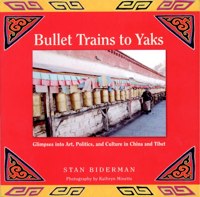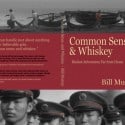 Stan Biderman, a self-described Silk Road enthusiast, set out with his wife, Kathryn Minette, on a five-week trip to explore western China and Tibet. The resulting travel memoir is Bullet Trains to Yaks: Glimpses into Art, Politics, and Culture in China and Tibet.
Stan Biderman, a self-described Silk Road enthusiast, set out with his wife, Kathryn Minette, on a five-week trip to explore western China and Tibet. The resulting travel memoir is Bullet Trains to Yaks: Glimpses into Art, Politics, and Culture in China and Tibet.
Biderman’s love of music and musical instruments, and Kathryn’s love of art prompted the trip, and are noticeable throughout their journey. The book is at its best when Biderman is describing shopping for rewaps in Kashgar, or their impromptu photo shoot with a street musician, who shows Biderman how to play the stringed instrument. The street markets and the western mountains are the draw.
Of their time in Tibet near the end of the trip, he says, “For us, the chanting monks and locals singing or playing instruments are the most magical times of this journey, moments of cultural transcendence. While many come to China to see the Buddhas and the tombs, I am far more intrigued by the activities of local people, especially musicians. I am drawn to life, and life is the present: I seek the instruments makers, the yak noodle soup, and the slices of donkey.”
Likewise, Kathryn’s intrepid spirit brings readers on camel rides in the Gobi desert, posing for photos in Turpan, and in search of precious art throughout the country. Her photos lend personality and fun to the book, though I would have liked to see the full-page color photos interspersed with the stories they accompany instead of hiding in the back.
No trip to such a remote destination would be complete without descriptions of exotic food–raw donkey, and fishball soup–strange toilets, and other oddities to western culture. Intestinal issues come hand-in-hand with exposure to different foods, but the reader is reminded constantly of the author’s reliance on Imodium and Pepto-Bismol.
It is obvious which locations were the author’s favorite. The narrative takes its life in the Kashgar and Lhasa chapters, and it is clear that the travelers reveled in these places more than the others. In Tibet, the author slows down to a poetic pace, taking in the Dalai Lama’s palace, and building a meditative atmosphere.
But Biderman does not hide his boredom well. In cities where there was little attraction culturally or artistically, the narrative is reduced to a factual recitation of the itinerary, or offhanded comments about the repressive government in China. Places like Beijing, Shanghai or Xian were obligatory stops, and in this way a daily diary is perhaps not the best format for this memoir.The narrative would have been better served if the corresponding obligatory commentary had been cut.
Peppered throughout the narrative are brief, poignant, and sometimes humorous snapshots of tour guides, airplane seatmates, and other random encounters. The spark of connection displayed here makes me wish for the travelers to drop their itinerary (impossible, I know), and follow these rabbit trails where ever they lead.
- Buy Travel Insurance
- Get a Car Rental
- Search for Great Tours HERE
- Book Your Accommodation HERE

 Book Review – “Common Sense and Whiskey”
Book Review – “Common Sense and Whiskey” Book Review: “The Food Traveler’s Handbook” by Jodi Ettenberg
Book Review: “The Food Traveler’s Handbook” by Jodi Ettenberg Book Review – “The Backpacker” by John Harris
Book Review – “The Backpacker” by John Harris Book Review – “Dear American Airlines” by Jonathan Mills
Book Review – “Dear American Airlines” by Jonathan Mills
